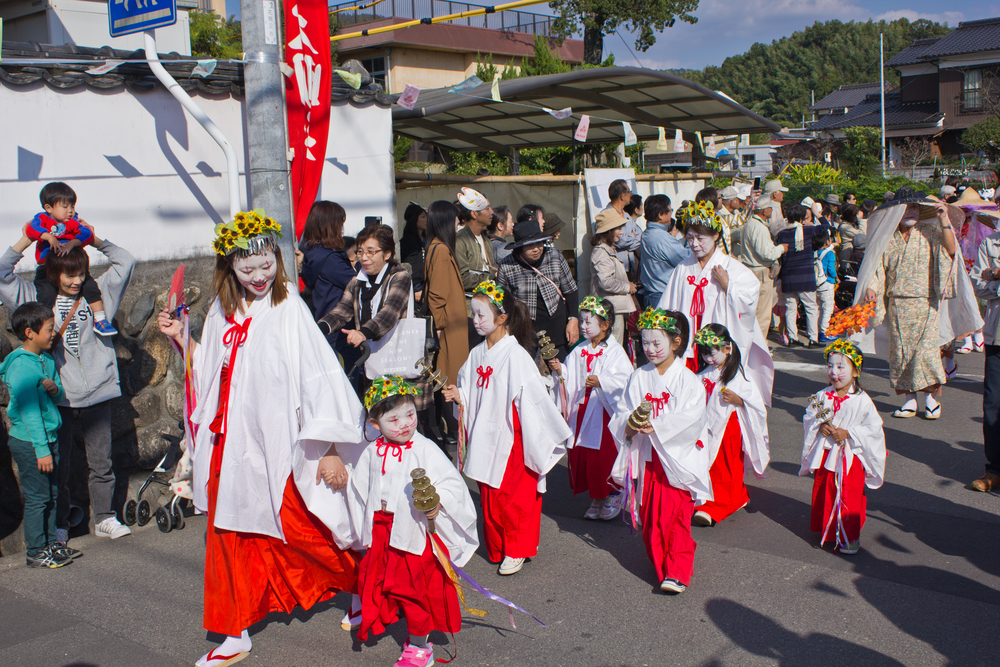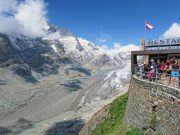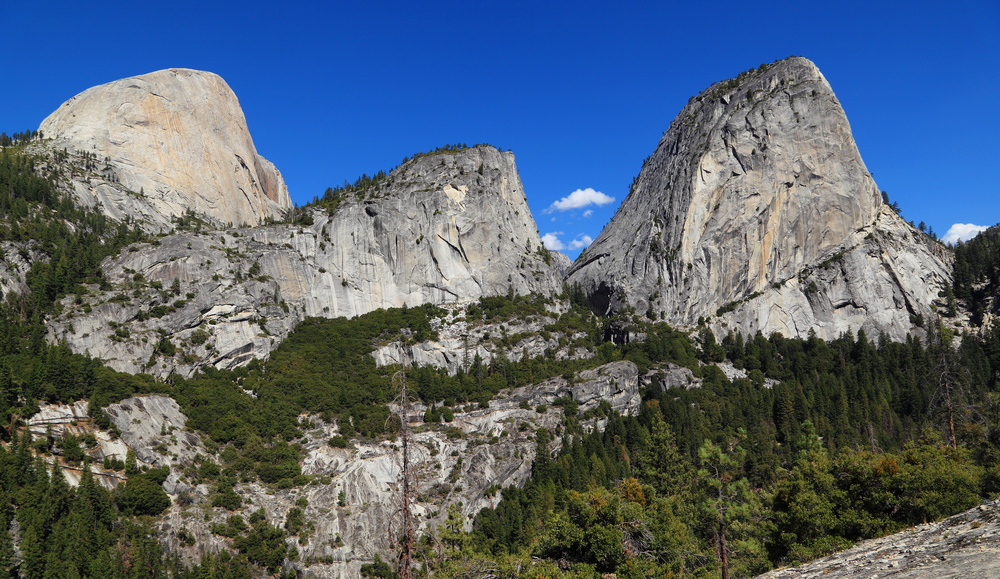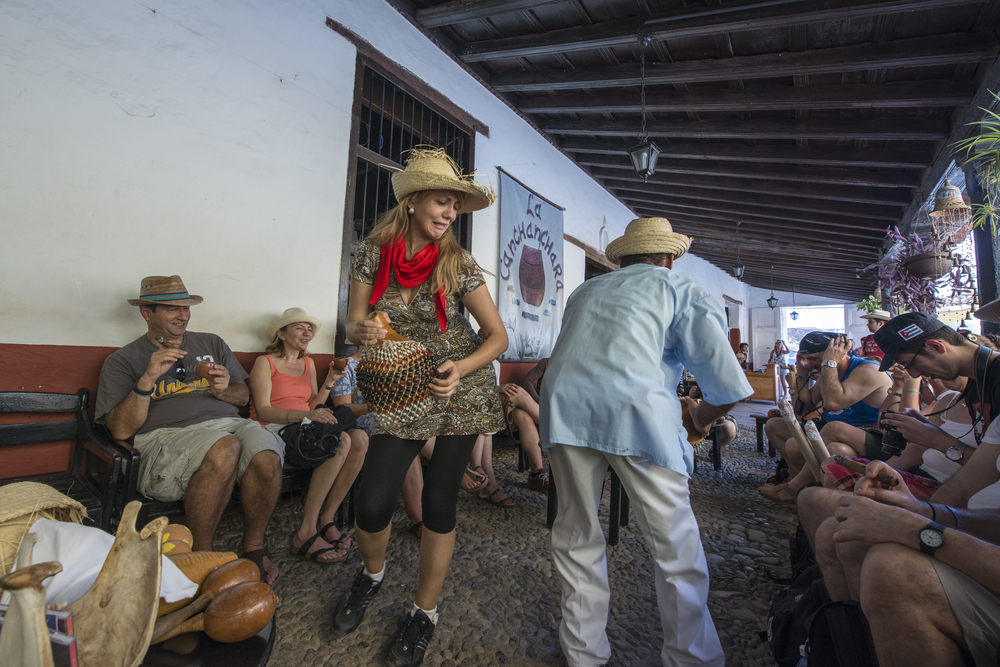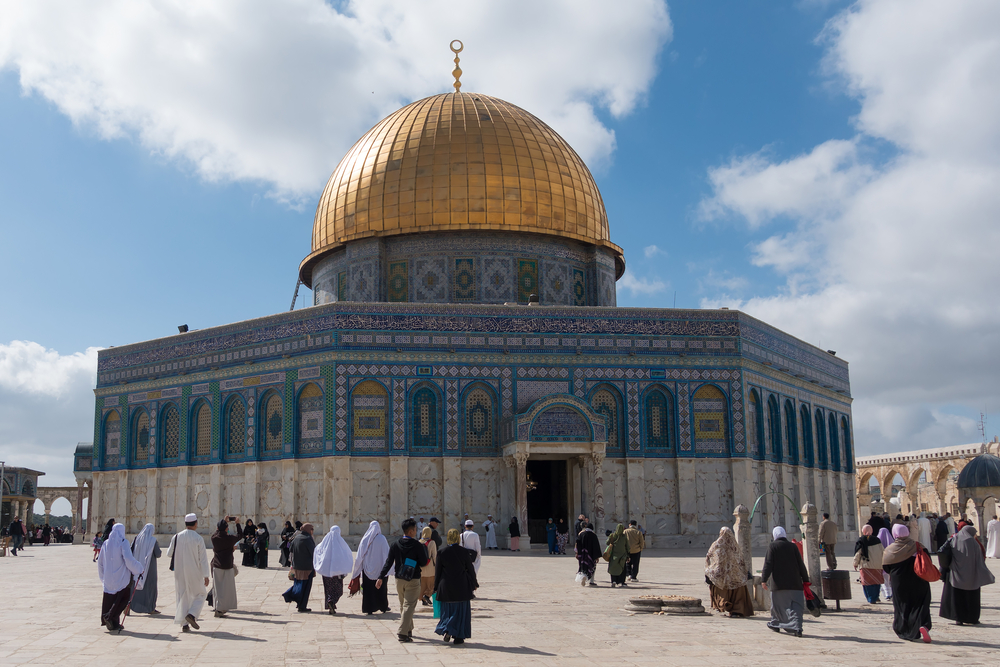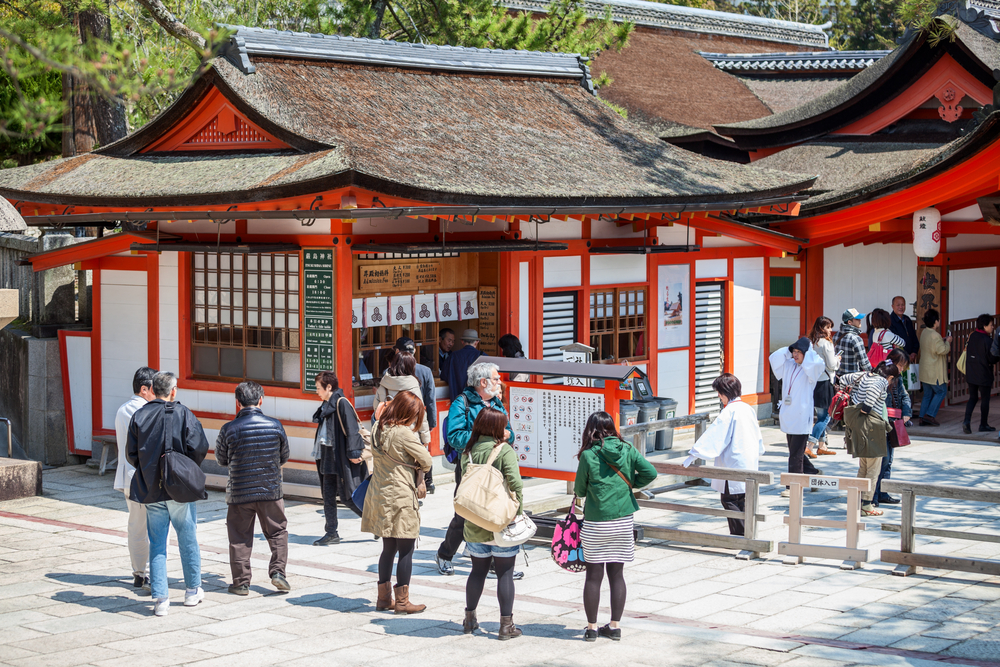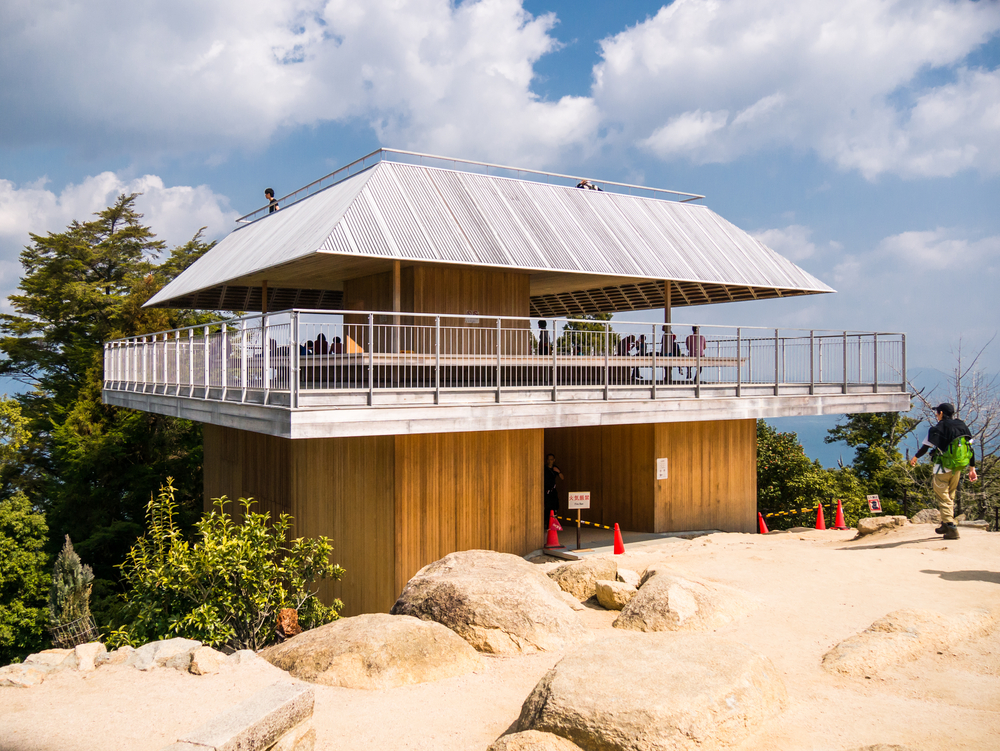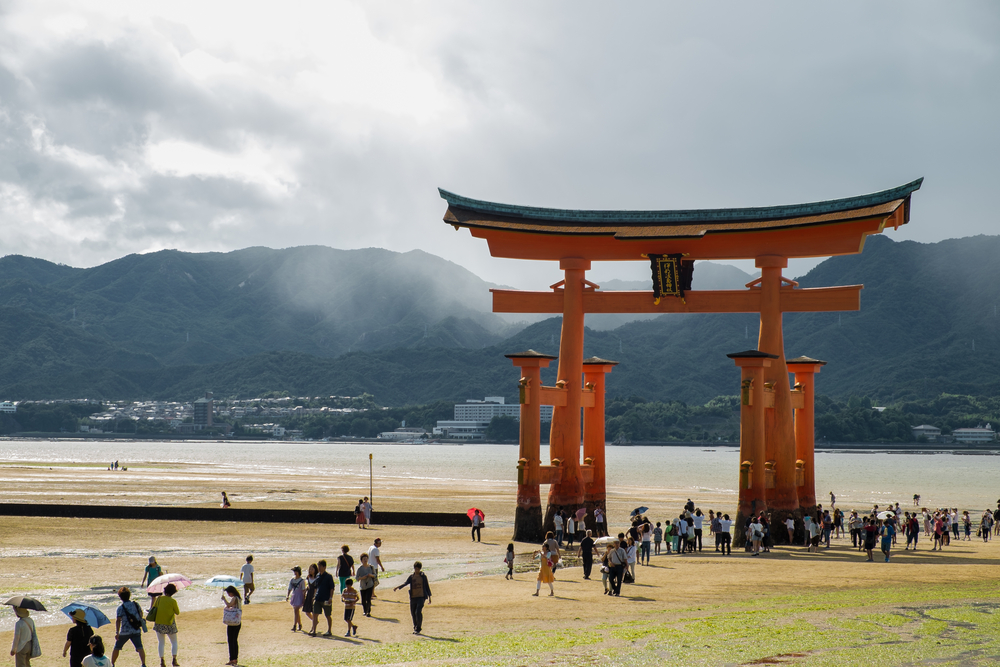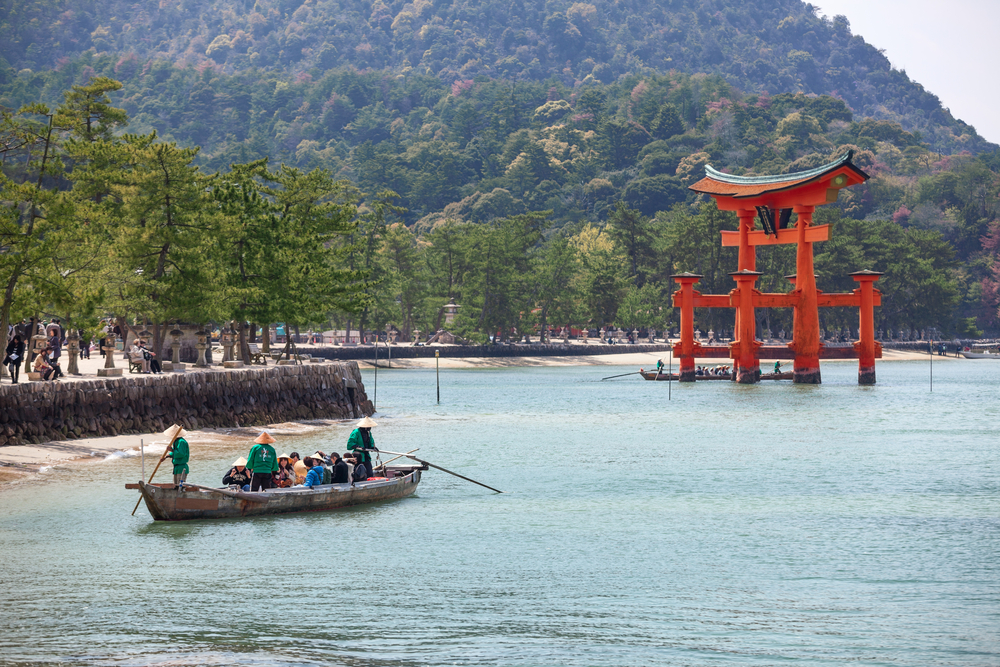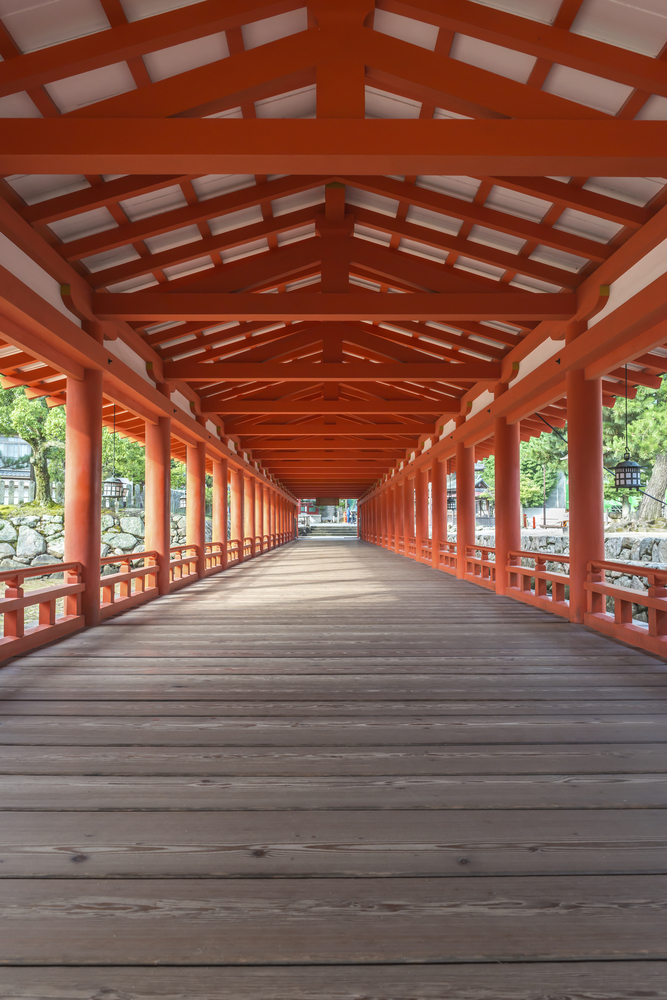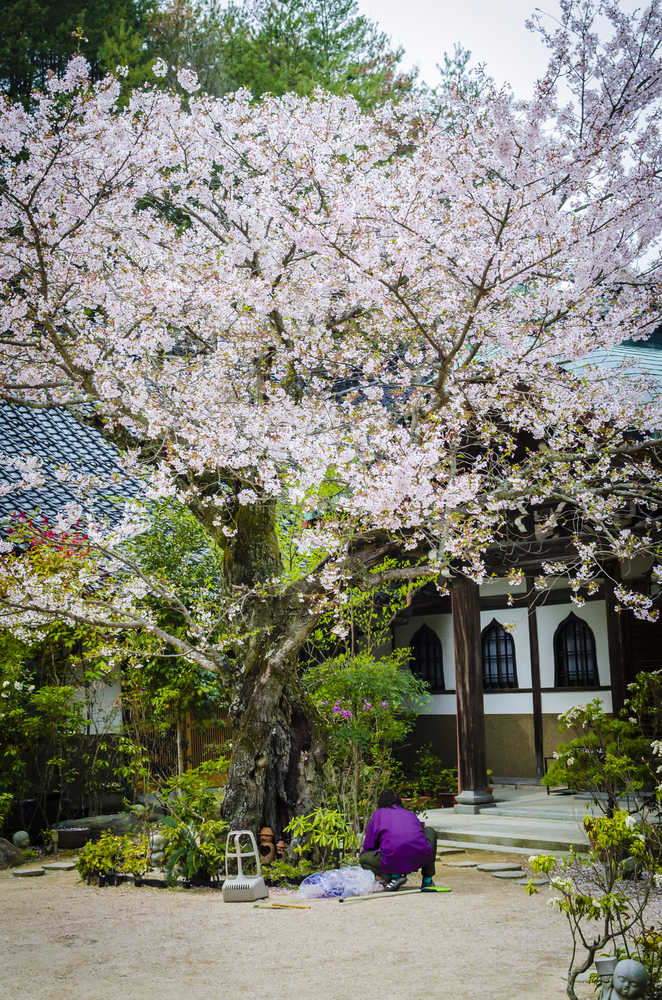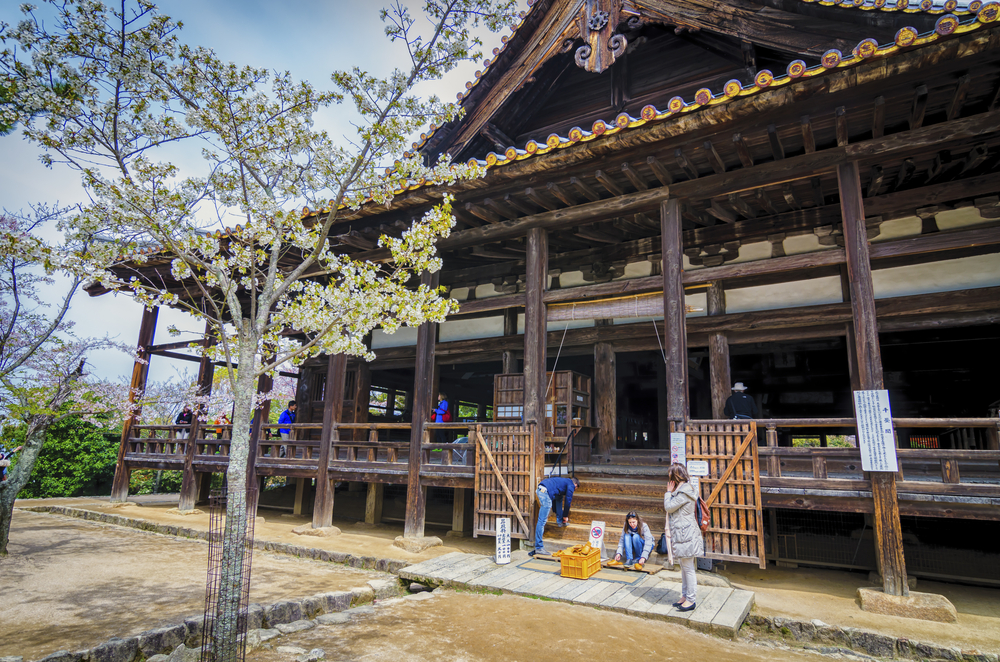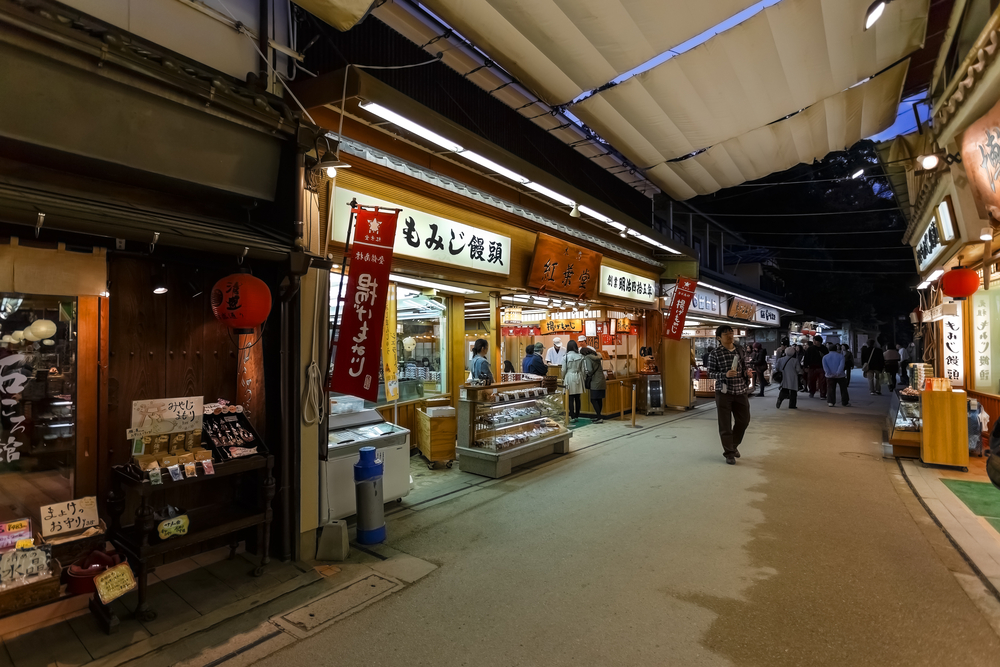Miyaijima is the popular name for the Itukushima island, which is located in northwest of Hiroshima Bay. The island is part of the west of the Inland Sea of Japan. The name Miyajima means the Shrine Island in Japanese. The Itukushima Shrine is the most well-known sightseeing in the island, and it is recognized as the World Heritage Site. Be well aware of the gorgeous deers wandering around the island when you travel through the ancient beauty.
MIYAJIMA, JAPAN – CIRCA APR, 2013: The entrance and ticket office of Itsukushima Shrine. Tourists buy tickets to visit the temples. Miyajima Island (Itsukushima), Japan (Kekyalyaynen / Shutterstock)
MIYAJIMAGUCHI, JAPAN – NOVEMBER 28, 2015: Big Red Torii, Streets and square full of tourist people, sea station for JR and Matsudai ferry pier departure Miyajima island (Itsukushima). (gnoparus / Shutterstock)
MIYAJIMA, JAPAN – APRIL 21: People visit gift shops on April 21, 2012 in Miyajima. Famous Miyajima island is a UNESCO World Heritage Site and a major tourism destination. (Tupungato / Shutterstock)
HATSUKAICHI, MIYAJIMA, JAPAN – CIRCA APR, 2013: An information board with a map and routes for visitors is on street of the city. The Miyajima Island (Itsukushima), Japan (Kekyalyaynen / Shutterstock)
HATSUKAICHI, MIYAJIMA, JAPAN – CIRCA APR, 2013: Many deers walk free along people on streets on the city sidewalk. The Miyajima Island (Itsukushima), Japan (Kekyalyaynen / Shutterstock)
HATSUKAICHI, MIYAJIMA, JAPAN – OCTOBER 28, 2013 : Japanese student and the sacred deer are on the city sidewalk. The Miyajima Island (Itsukushima), Japan (thipjang / Shutterstock)
MIYAJIMA, JAPAN – OCTOBER 27 : Traditional costume on 27 October 2015. Miyajima, Japan. Miyajima was a sacred island with long history and tradition. (Attila JANDI / Shutterstock)
MIYAJIMA, JAPAN – MAY 5 : People digging for shellfish at low tide on the shoreline of Miyajima, Japan on 5th May 2012. The collected shellfish are often used in Miso soup. (antb / Shutterstock)
MIYAJIMA, JAPAN – MARCH 28: Mt Misen on March 28, 2015 in Miyajima, Japan. Miyajima is a shinto holy site and listed in the World heritage of UNESCO. (Pabkov / Shutterstock)
MIYAJIMA, JAPAN – APRIL 19:Japanese man in samurai costume on April 19, 2014 in Miyajima, Japan. Samurais were the soldiers in the shogun’s army and they were feared all over Japan in the Middle Ages. (Attila JANDI / Shutterstock)
MIYAJIMA, JAPAN – OCTOBER 27 : Itsukushima Shrine on 27 October 2015. Miyajima, Japan. Izsukushima is one of the most important and sacred Shinto shrine in Japan. (Attila JANDI / Shutterstock)
Miyajima Island, Japan – Sep 5 : The old bronze statue of protecting lion in the famous Itsukushima shrine that believed to protect the shrine from evils, Japan on Sep 5 2014 (pattang / Shutterstock)
MIYAJIMA, JAPAN – April 16: Giant Torii during low tide near Itsukushima shinto shrine in Miyajima, Hiroshima, Japan on April 16, 2014. (Supachita Ae / Shutterstock)
HIROSHIMA, JAPAN – APRIL 11, 2014: Japanese girls with Japanese traditional suit Yukata take photo with Torii at Itsukushima island in Hiroshima, Japan. This island is popularly known as Miyajima. (MrNovel / Shutterstock)
MIYAJIMA, JAPAN – AUG, 2013: Many visitors are going to red wooden sacred torii gate at sea low tide. The Miyajima Island, Japan (Peerapong W.Aussawa / Shutterstock)
MIYAJIMA, JAPAN – OCTOBER 24: Itsukushima Shrine at October 24, 2014 in Miyajima, Japan. Miyajima is a shinto holy site and listed in the World heritage of UNESCO. (Attila JANDI / Shutterstock)
MIYAJIMA, JAPAN – CIRCA APR, 2013: Small boat with visitors is in bay during excursion to red wooden sacred torii gate at sea high tide. The Miyajima Island (Itsukushima), Japan (Kekyalyaynen / Shutterstock)
MIYAJIMA, JAPAN – AUGUST 14: Early morning looking down a long corridor at the famous the Itsukushima Shrine on Miyajima shown on August 14, 2015 in Miyajima, Japan (af8images / Shutterstock)
MIYAJIMA , JAPAN – circa APRIL 2009: One of the many temples on this island that is so sacred that births and deaths are not allowed there , Miyajima Japan, circa April 2009 (Emma manners / Shutterstock)
MIYAJIMA, JAPAN – 7 APRIL,2014 :Kannon-d Hall of Daisho-in temple . This temple is within the World Heritage Area of Itsukushima Shrine. (Korkusung / Shutterstock)
MIYAJIMA, JAPAN – 7 APRIL,2014 : Ema praying tablets at Daisho-in temple Ema are small wooden plaques used for wishes by shinto believers. (Korkusung / Shutterstock)
Nio Kings guarding the entrance to the Daisho-in Temple at Miyajima Hiroshima on 21 OCT 2015 (siamcreate / Shutterstock)
MIYAJIMA, JAPAN – 7 APRIL,2014 :Spinning Mani Wheel (prayer wheel) is believed to invite blessings equivalent to reading one volume of the Hannya-shinkyon or Heart Sutra.- Daisho-in temple (Korkusung / Shutterstock)
MIYAJIMA, JAPAN – 7 APRIL,2014 : The cherry blossom (sakura) is Japan’s unofficial national flower. It has been celebrated for many centuries and holds a very prominent position in Japanese culture. (Korkusung / Shutterstock)
MIYAJMA,JAPAN – 7 APRIL, 2014 :Senjokaku means “pavilion of 1000 mats”The name describes the spaciousness of the building, as Senjokaku is approximately the size of one thousand tatami mats. (Korkusung / Shutterstock)
ITSUKUSHIMA SHRINE, MIYAJIMA – DECEMBER 24 : Japanese people washing hand in a temple on December 24, 2013 in Itsukushima Shrine, Miyajima, Hiroshima. (hacksss / Shutterstock)
Hiroshima Japan – 31 Dec 2011: A lady selling traditional Japanese snack at Miyajima (tipwam / Shutterstock)
MIYAJIMA, JAPAN – NOVEMBER 15: Grilled Oyster in Miyajima, Japan on November 15, 2013. Grilled oyster with soy sauce is very popular for the tourist at Omotesando Shopping Street (cowardlion / Shutterstock)
MIYAJIMA, JAPAN – APRIL 1: Local man fries oyster at April 1, 2014 in Miyajima, Japan. Oyster is very famous and delicious in Miyajima. (Attila JANDI / Shutterstock)
MIYAJIMA, JAPAN – NOVEMBER 15: Ishidorii in Miyajima, Japan on November 15, 2013. Ishidorii is a type of torii that made of stone. The torii is in front of Itsukushima shrine (cowardlion / Shutterstock)
MIYAJIMA, JAPAN – NOVEMBER 15: Omotesando Shopping street in Miyajima, Japan on November 15, 2013. The liveliest place in Miyajima and visited by most tourists. The place is nearby the Otorii gate (cowardlion / Shutterstock)
MIYAJIMA, JAPAN – NOVEMBER 15: Omotesando Shopping street in Miyajima, Japan on November 15, 2013. The liveliest place in Miyajima and visited by most tourists. The place is nearby the Otorii gate (cowardlion / Shutterstock)
Miyajima – Sacred Island
By Menahem Fogel
The really, really fast Shinkansen brought me from Kyoto to Hiroshima at 300kph. Whoa!
Hiro=Wide. Shima=Island. Hiroshima=Wide Island. It’s actually not an island, but a group of islands created by the numerous rivers that come down from the mountain and run through the city. Once I arrived here, I went directly to the ferry station for the crossing to Miyajima Island. Miya=Holy and Jima=Shima=Island. Miyajima=Holy Island. Once again, the Shinto equivalence of holiness with beauty – and the place is indeed very, very beautiful.
Just offshore in the water is located Japan’s most famous vermilion Torii, built originally in the 17th century, and indicating the passage into a sacred location. The island is also teeming with deer that seem to live with us humans quite fine, thank you. They are really pesky and keep nudging for food and when they aren’t provided any, they start chewing on whatever is at hand – like my jacket sleeve.
As I meandered along, I came across a wedding party enjoying some elaborate Shinto dance ritual. I didn’t understand the Bugaku or its significance, but the intricate dance was quite wild, and the live music played by a group of Shinto priests accompanying the dancing priest, was charming. I doubt the Talmudic discussion between the schools of Hillel and Shammai, regarding how one is to dance before a bride, ever made its way here. But, oh boy, this was one big and blustery boogie! I then strolled around the shrines on this most beautiful island, did some shopping and made my way back to the ferry, across the sea and to the bus, from where I proceeded to my hotel.
A little about the hotels: the one where I stayed in Tokyo was lovely. The rooms were divided between the bedroom area and the living area. Very comfortable beds, MUCH better than those I slept in, in China. The hotel in Hakone was exceptional too – very ornate, beautiful gardens, full-service only, no buffet breakfast; very high end. And it had its own “onsen” (mineral hot spring bath – more about those another time). My single room in the hotel in Kyoto was as wide as my bed plus 100cm. I kid you not. I once stayed in Amersfoort, Netherlands in a place like that. Then it was a novelty. Now it was disappointing! But that was made up by my hotel here in Hiroshima which was very, very fancy.
Late that night I went for a walk through the deserted streets of Hiroshima. Passed a Pachinko Palace (more details on that phenomenon will come along with the onsen too) where the gamblers were busy with their hands feverishly working the pull-bar. I also passed a used car lot where the cutest little Mitsubishi city cars were on sale. At 11:15 p.m. I called the front desk and requested a massage. So this 60-year-oldish woman comes to my room holding what appeared to be a bag of tools. She looked like Rosa Klebb. Remember her? She was James Bond’s sworn enemy in “From Russia with Love,” the one with the poisoned spike in her shoe. My masseuse spoke no English, but with lots of “Hai!”s, we managed to make ourselves understood. She strolled into the room, took of her shoes, hopped on the bed and proceeded to roll off the duvet, placed a special cushion on the bed, and told me in hand-language to put on the yukata (robe) that’s hanging in the closet.
Anyway, once she had me on the bed she proceeded to give me one of those good old deep penetrating Shiatsu massages. At the beginning it was seriously painful, but as she continued and I relaxed, it got better. She left, and for the first time since arriving here, I had a good, solid, uninterrupted 5 hours of sleep. Fantastic!
Article Source: http://EzineArticles.com/expert/Menahem_Fogel/368435
http://EzineArticles.com/?Miyajima—Sacred-Island&id=2612494



